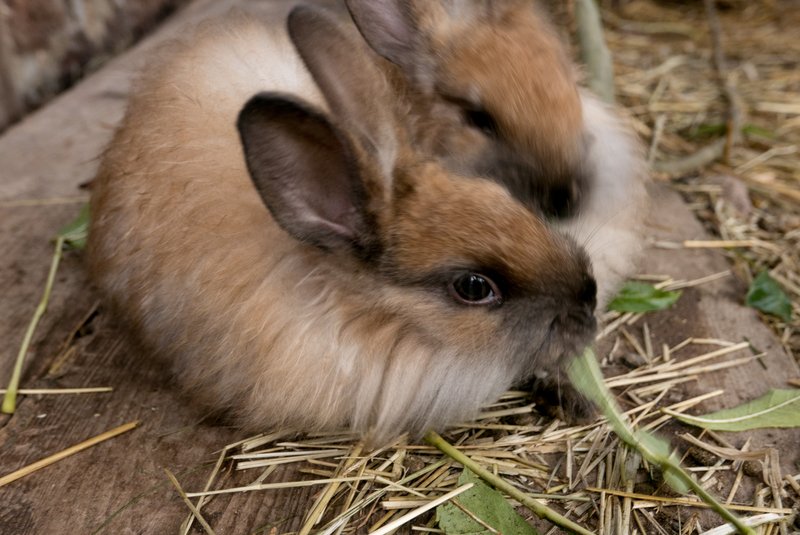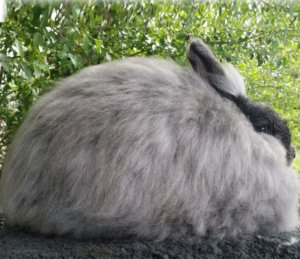Satin Angora rabbits have the best fur compared to all Angora breeds. They have beautiful coats, and some love their clipped fur to spin into yarn. Besides their coats, they are also known as docile and friendly pets. They can quickly get along with anyone, even strangers! But like other long-haired breeds, they need regular grooming. Learn more about these beautifully-coated bunnies through this blog post!

Satin Angora Rabbits
Facts about Satin Angora Rabbits
| Body Size | Medium |
| Body Weight | 3.5 lbs to 9.5 lbs |
| Body Shape | Commercial |
| Life Span | 7 to 12 years |
| Colors | Brown, grey, white, tan |
| Rarity | Common |
| Similar Breeds | Satin rabbit, French Angora |
| Best Suited for | Families with or without children, couples, singles |
| Origin | Canada |
Background and History
The first attempt to develop a “satinized-wooled” bunny was by John C. Fehr during the 1930s. However, he thought the breed had no commercial value because of its weak fur. After fifty years, Mrs. Leopoldina Meyer of Canada ventured into the same project. She crossbred a copper satin rabbit with longer-than-normal wool to a French Angora. The result was the first Satin Angora rabbit.
Breeders tend to mistake Satin Angora for French Angora because of their resemblance. However, Satin Angora has a distinct wool. All Angora bunnies have opaque fur, but the pigment of Satin Angora’s wool is translucent. It is called a sheen. Compared to all Angora breeds, it also has the finest fur.
Although Satin Angora produces less wool than other breeds, its fur is one of the most valuable fiber. The American Rabbit Breeders Association (ARBA) acknowledged the breed in 1987. As of today, it is a popular fiber animal and a domesticated bunny.
Fun Fact:
The Satin fur is caused by a gene mutation that causes the guard hairs to be transparent. This then reflects the light in a brilliant and unusual manner, giving the satiny appearance.
Features of Satin Angora Rabbits
Body Size
Regarding the shape of the body, Satin Angora and French Angora have similarities. Both of them have commercial types of bodies, but Satin Angoras are slightly smaller. They can only reach a maximum weight of 9.5 lbs, while French Angoras can grow up to 10.5 lbs.
Satin Angora’s oval head is in proportion to its body. It also has a broad forehead and a narrow muzzle. Some Satin Angoras have plain ears, while some have slight tuft to the tip of their ears.
The junior buck and doe for rabbit shows must not be over 6 ½ lbs or less than 3 ¾ lbs. On the other hand, the senior buck and doe must not be over 9 ½ lbs and must not be less than 6 ½ lbs. The ideal weight of a Satin Angora is 8 lbs.

Coat
The Satin Angora bunny has the finest coat out of all the Angora breeds. The diameter of their fur is thinner in comparison to regular wool. It also has lustrous wool caused by its recessive gene. Other Angora bunnies have opaque wool, but Satin Angoras have translucent ones. You will notice the sheens on their heads and ears.
If you look closely at a Satin Angora, you may observe that the color of its ears, nose, and head differs from its body. On rabbit shows, 60 points go for the wool. The judges based it on density, texture, length, and sheen. When judging the density, the underwool must be thick and crimped. Below are the available colors of Satin Angora bunnies:
| Categories | Colors |
| White | Red-Eyed White (REW), Blue-Eyed White (BEW), Pointed White (Chocolate, Black, Lilac, Blue) |
| Broken | Broken |
| Colored | Chestnut, copper, chinchilla, chocolate chinchilla, lilac chinchilla, chocolate agouti, opal, lynx, squirrel |
| Self | Chocolate, black, lilac, blue |
| Shaded | Sable, seal, pearl (chocolate pearl, black pearl, smoke pearl, sable pearl, lilac pearl, blue pearl) |
| Tortoiseshell | Tortoiseshell, chocolate tortoiseshell, blue tortoiseshell, black tortoiseshell |
| Ticked | Steel, chocolate steel, blue steel, lilac steel |
| Wideband | Red, fawn, cream |
Temperament and Behavior
As fiber animals, Satin Angora rabbits are used to handling and picking. They are also friendly, making it easy for them to get along even with strangers. As house pets, they like well-behaved cats. They prefer to take a nap on the corner of the house and greet their owners when they arrive.
Since Satin Angoras are sociable animals, giving them attention is necessary. You can get them a rabbit companion if you don’t have time. These bunnies are also natural clowns. They love playing games with their owners and hopping around the house. Because of their docile personality, they can get along with children. You will rarely see an aggressive Satin Angora.
If you plan to keep a Satin Angora, you must give it some toys. These bunnies are intelligent, so they need something stimulating their minds. They are ideal for families, couples, or singles longing for cuddles. Because of their long coats, they can be challenging pets to inexperienced owners.
Grooming Satin Angora Rabbits
Satin Angora rabbits need grooming since their fine coats are prone to matting. If they are in their non-shedding season, you can brush their coat at least twice or thrice a week. However, you must brush their coats regularly if they are molting. This procedure is needed to prevent the bunny from ingesting its wool.
Without grooming, the wool of this long-haired bunny may grow thick with dirt and stains. Besides brushing, you must visit its groomer at least four times a year to have its coat trimmed. These bunnies love their coats sheared since they cannot feel any discomfort. You can use their wool to make clothes and blankets.
Another grooming habit that a Satin Angora must not miss is nail trimming. You must trim its nails at least once a month. But the nails will grow slower if you have scratching and digging points in its cage. Letting your bunny grow its nails may lead it to injure itself or its owner. If you are afraid to cut your pet’s nails, don’t hesitate to go to the vet for the procedure.
Brushing a Satin Angora’s teeth is also necessary, especially if it has plaque build-up. You can purchase toothpaste specifically for pets. You may also ask a vet what’s the best product to use. In applying it to your bunny’s teeth, you have to rub it on both sides of the tooth gently. You can use an electric brush or cotton wool buds.
Proper Diet of Satin Angora Rabbits

Bunnies eating leafy greens
The diet of Satin Angora bunnies consists of hay, clean water, pellets, and vegetables. Hay is the best source of fiber that you can give to your bunny. It helps in the motility of the bunny’s stomach, making it easier for them to pass stools. Besides, it helps trim their teeth, preventing overgrowth of their incisors and molars.
There are different kinds of hay that you can give to Satin Angora. Timothy hay is the most popular food since it can work well with their digestive systems. It is also very high in fiber and low in protein, fitting the perfect diet for rabbits.
You can also mix the types of hay to encourage variations in your bunny’s diet. It also enables a fussy bunny to eat more. It discourages a non-fussy bunny from staying on one type of hay. Other choices include meadow grass hay, orchard hay, and oat hay. When selecting the hay, ensure it is fresh and free from excessive dust.
Another food that you must feed your bunny is pellets. However, it must only be 10% of its diet. When choosing pellets, make sure that they are plain and that there are no seeds, nuts, or colored ones. It must also be high in fiber and low in protein. You must ensure that there is calcium and fats.
Giving vegetables to your bunny is highly encouraged. But make sure that you provide them in moderate amounts. As a warning, not all veggies are suitable for rabbits. Some of them are fatal when consumed. You should not give your pet some vegetables such as rhubarb, broad beans, and iceberg lettuce.
Habitat

Because of the thick coats of Satin Angora rabbits, it is ideal for them to live in cooler places. Well-ventilated garage or vacant room is a good place for them to stay. You can also put them outdoors but ensure they are safe from harsh weather and predators. Cages outdoors must also be above the ground to keep the bunny safe.
In building a cage for a Satin Angora, it must be massive enough for the bunny to hop around. The minimum area is 12 feet. However, it may depend on the size of the bunny. The best flooring for the cage is solid metal since it is easier to clean and is more comfortable for rabbits. You must also put some cardboard boxes inside the hutch to serve as hiding places for your pet.
Wool block
Wool block is most common to long-haired rabbits like Satin Angora. Unlike cats, bunnies can’t vomit. Whenever they ingest their wool, it stays inside their stomach. Once there is a large amount of wool inside their stomach, it will affect their digestion. This condition is fatal, so immediate medical attention is needed.
Some of the symptoms of wool block include the following:
- Sudden loss of appetite
- Misshapen stools
- Visible hair on the stools
- Less frequent passing stools
The treatment for wool block is a medicine that will encourage motility. But if the case is severe, the vet may perform surgery to remove the wool from the rabbit’s stomach. The best way to prevent wool block is by grooming a Satin Angora regularly.
Frequently Asked Questions
Are Satin Angoras good pets for children?
Satin Angora can quickly get along with children because they are gentle and docile. However, the kids need to have the supervision of an adult when grooming a Satin Angora. Without proper grooming, these bunnies may suffer from a wool block. Also, ensure your children handle them properly since they have soft spines.
How much are Satin Angora rabbits?
Satin Angora rabbits can cost from $150 to $300. Since they are fiber animals, they are considered money-making machines. You can sell their wool for $16 per ounce, especially if it is high in quality.
Considering a Satin Angora Rabbit?
Satin Angora rabbits have lustrous coats loved by rabbit owners and wool manufacturers. They are also popular pets since they are very affectionate and friendly. However, grooming their coats can be challenging since they are dense and fine. These bunnies may suffer from wool block and other health issues without proper grooming.
Read More


